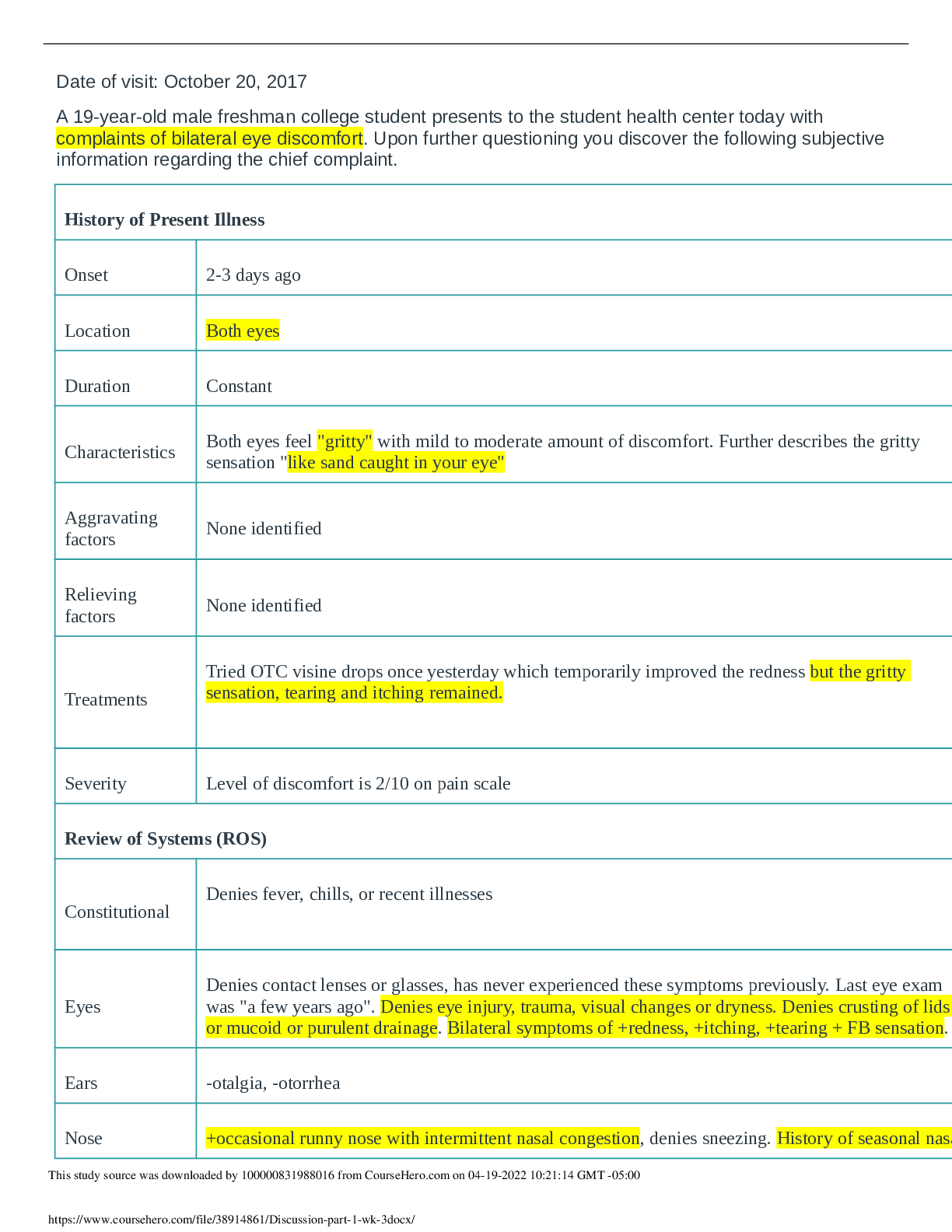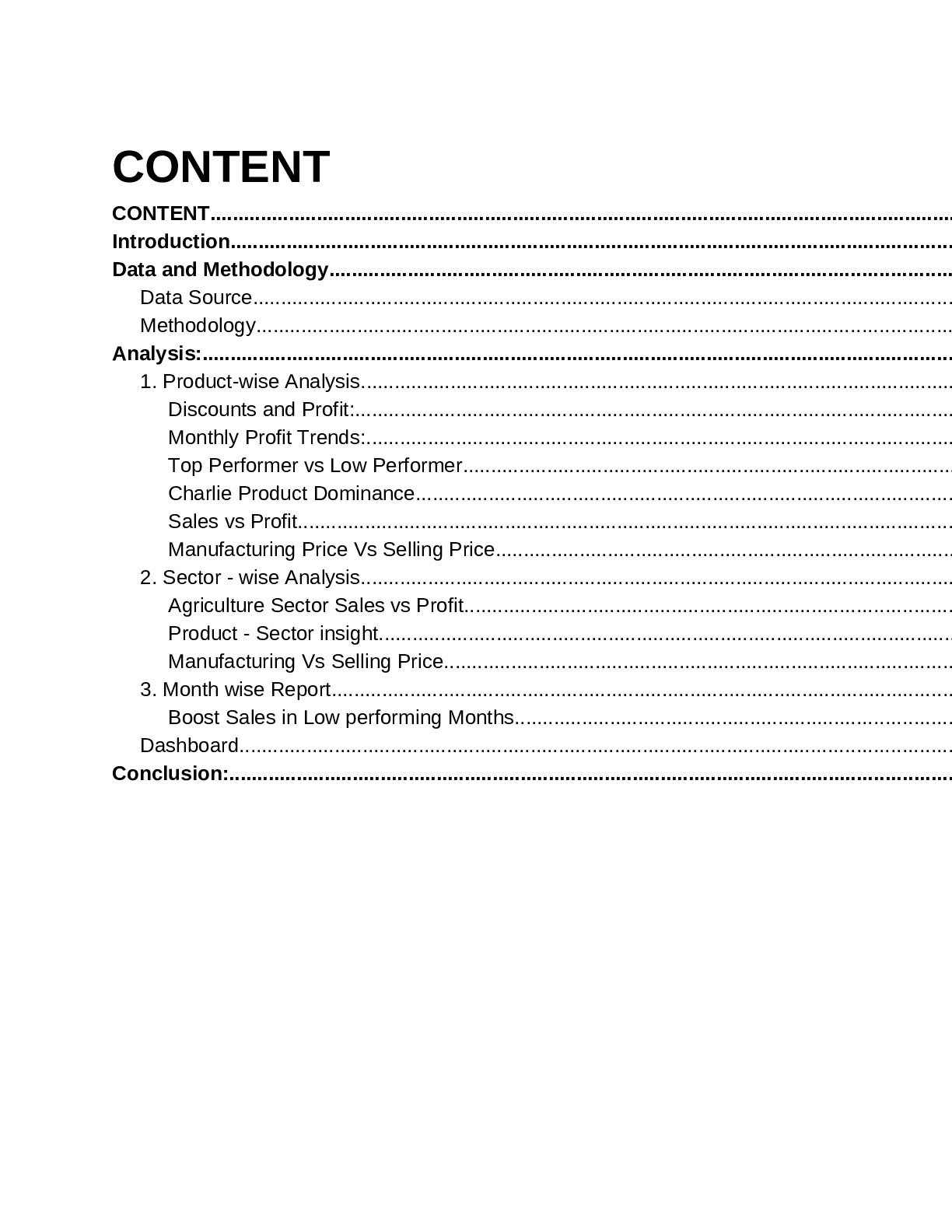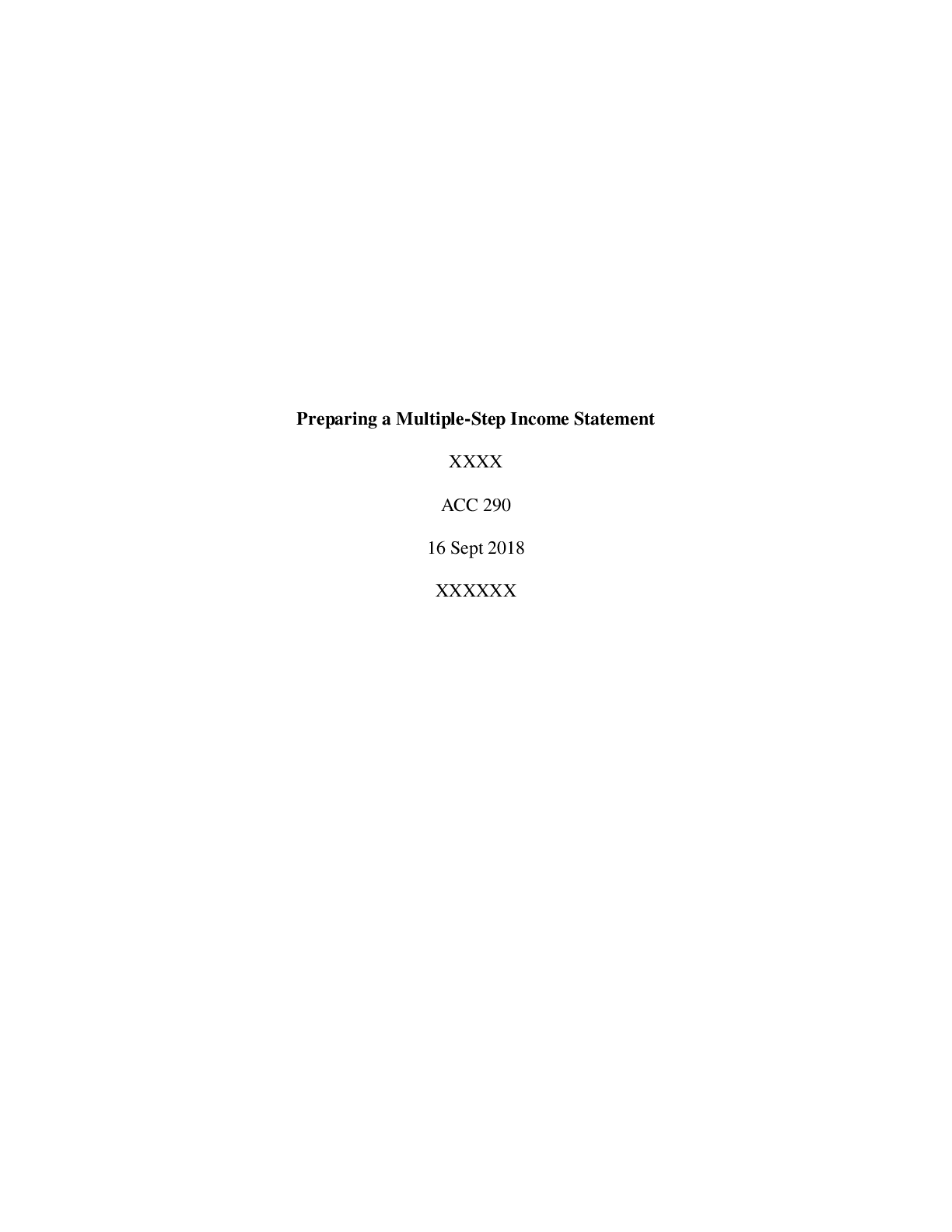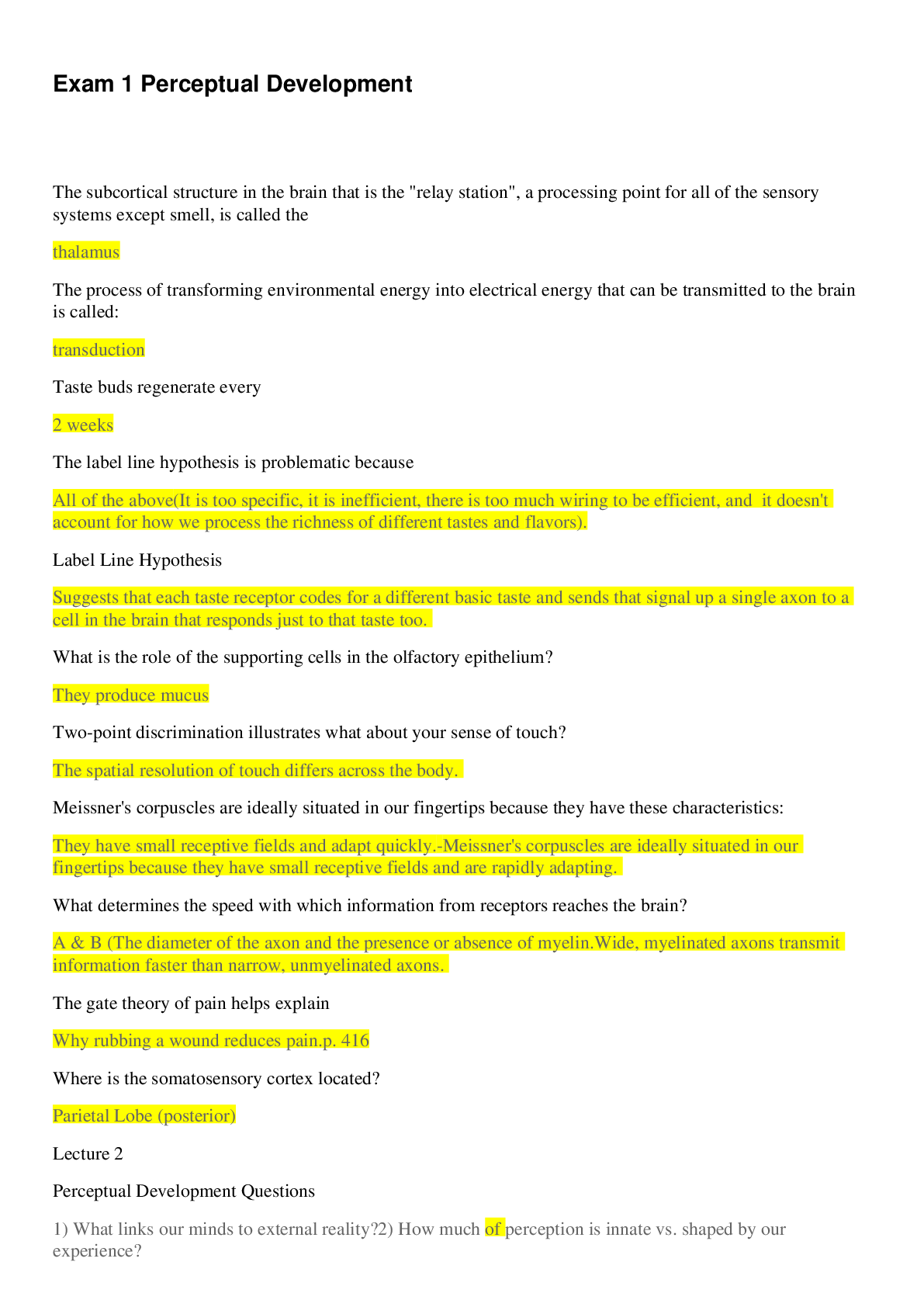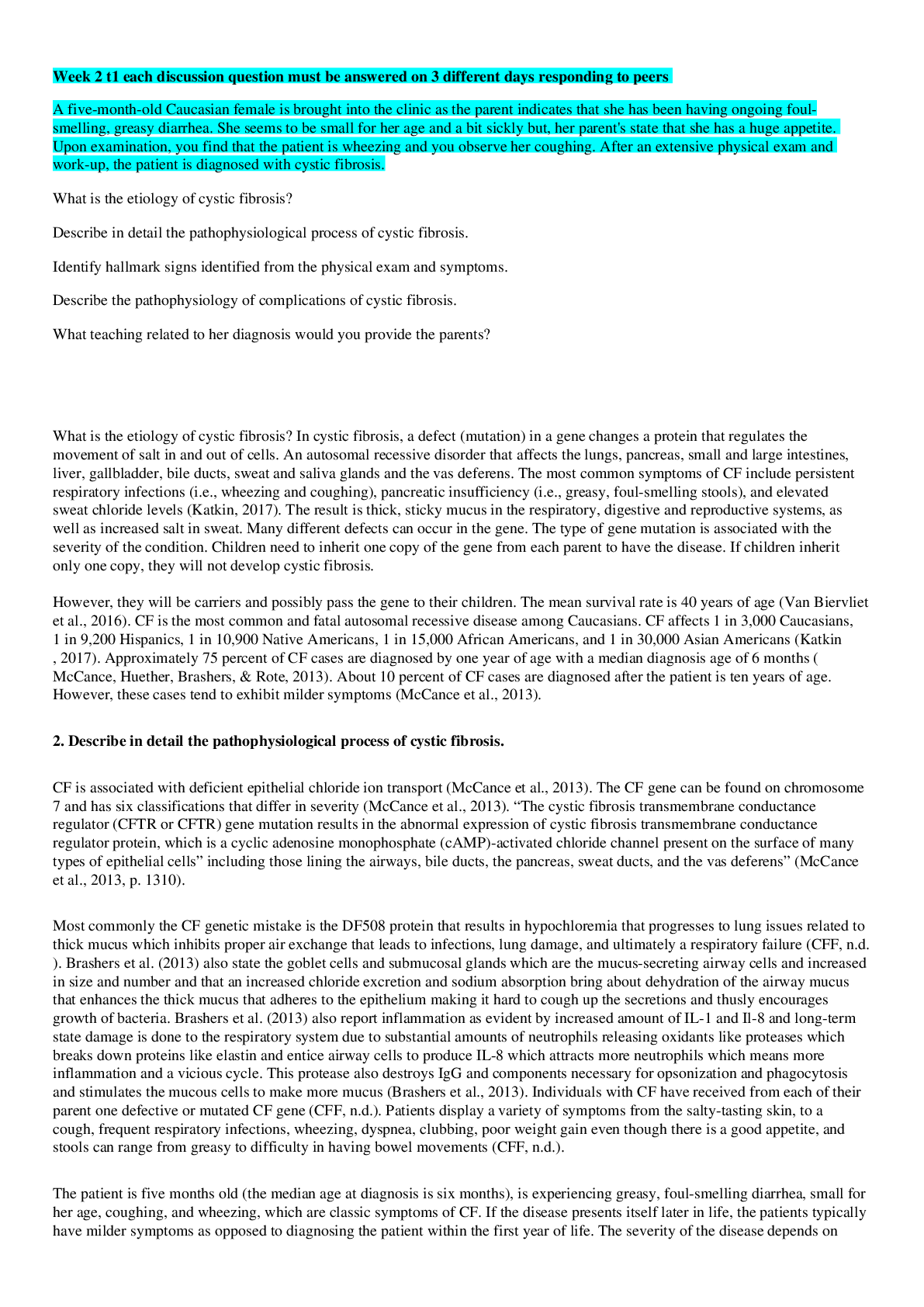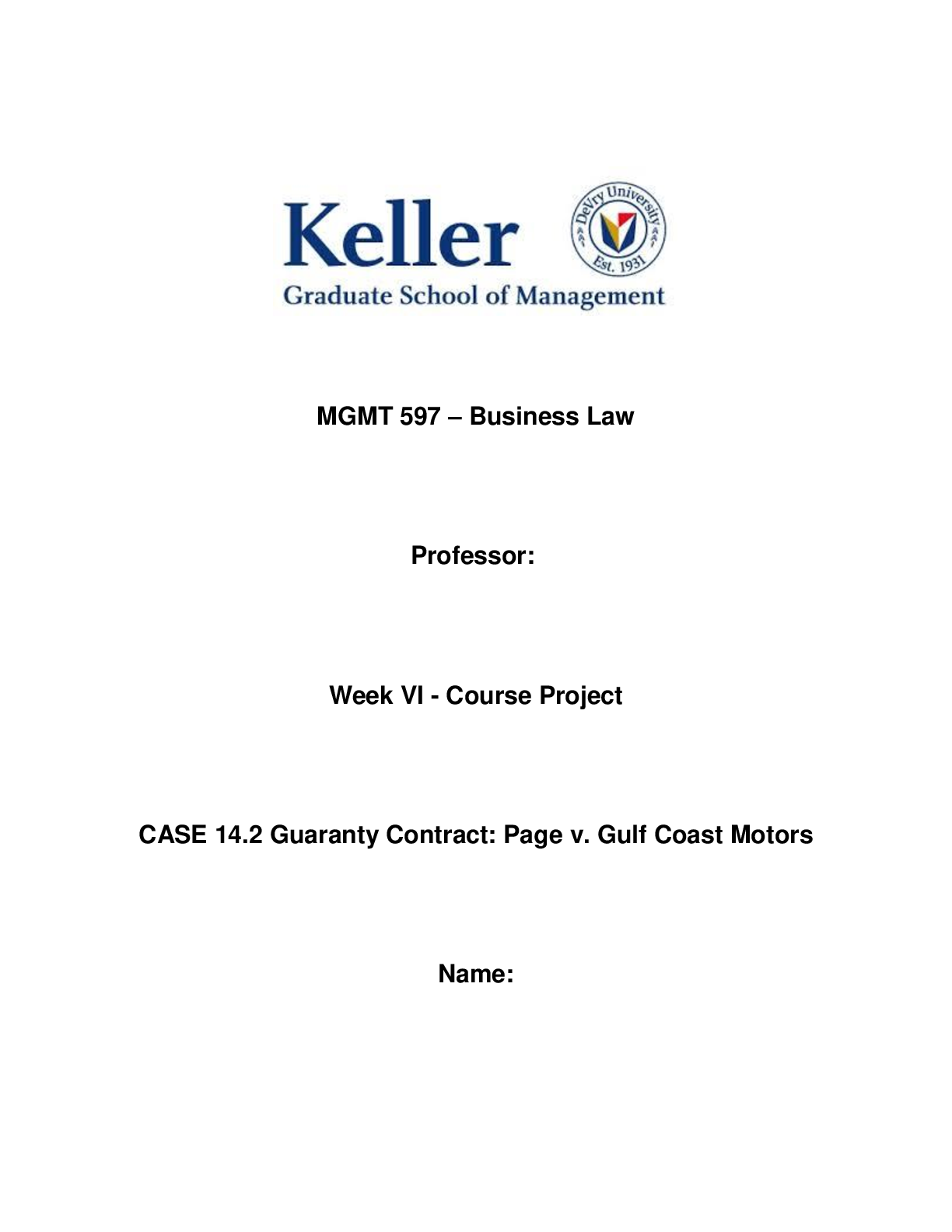History > CASE STUDY > Lipids Case Study (All)
Lipids Case Study
Document Content and Description Below
Term Spring Professor N/A Tags Test Unformatted text preview: 336 PART 2 ■ CLINICAL CORRELATIONS AND ANALYTIC PROCEDURES the ATP-binding cassette transporter family52 that pumps various ligand... s across the plasma membrane. Defects in the gene for the ABCA1 transporter lead to A 52-year-old man went to his physician for a Tangier disease, a disorder associated with low HDL physical examination. The patient had been a district and a predisposition to premature coronary heart dismanager for an automobile insurance company for ease.53 The exact mechanism of the ABCA1 transporter the past 10 years and was 24 pounds overweight. He is not known, but it is believed that the transporter had missed his last two appointments with the modifies the plasma membrane by transporting a lipid, physician because of business. The urinalysis which then enables apo A-I that has dissociated from dipstick finding was not remarkable. His blood HDL to bind to the cell membrane. In a detergent-like pressure was elevated. The blood chemistry results extraction mechanism, apo A-I then removes excess are listed in Case Study Table 14-1.1. cholesterol and phospholipid from the plasma memLipid profile brane of cells to form a discoidal-shaped HDL partiQuestions cle.54 The newly formed HDL is then competent to ac1. Given the abnormal tests, what additional cept additional cholesterol by the aqueous diffusion information would you like to have? pathway and is eventually converted into spherical HDL 2. If this patient had triglycerides of 100 mg/dL by the action of LCAT (Fig. 14-3). Recently, ABCG1, (1.1 mmol/L) and an HDL cholesterol of another ABC transporter, has been described to facili23 mg/dL (0.6 mmol/L), what would be his tate the efflux of cholesterol to lipid-rich spherical HDL calculated LDL cholesterol value? 167, use the one with 5 via a mechanism that appears to be different than the ABCA1 transporter.55 3. If, however, his triglycerides were 476 mg/dL (5.4 mmol/L), with an HDL cholesterol of LIPID AND LIPOPROTEIN POPULATION 23 mg/dL (0.6 mmol/L), what would be his DISTRIBUTIONS calculated LDL cholesterol value? triglycride above 400, CASE STUDY 14-1 CASE STUDY TABLE 14-1.1 LABORATORY RESULTS ANALYTE ⫹ Na ⫹ PATIENT VALUE 151 REFERENCE RANGE 135–143 mEq/L Serum lipoprotein concentrations differ between adult men and women, primarily as a result of differences in sex hormone levels, with women having, on average, higher HDL cholesterol levels and lower total cholesterol and triglyceride levels than men.56 The difference in total cholesterol, however, disappears after menopause as estrogen decreases.57 Men and women both show a tendency toward increased total cholesterol, LDL cholesterol, and triglyceride concentrations with age. HDL cholesterol concentrations generally remain stable after the onset of puberty and do not drop in women with the onset of menopause. General adult reference ranges are shown in Table 14-3. Circulating levels of total cholesterol, LDL cholesterol, and triglycerides in young children are generally much lower than those seen in adults.58 In addition, concentrations do not significantly differ between boys and girls. HDL cholesterol levels for both boys and girls are K 4.5 3.0–5.0 mEq/L Cl⫺ 106 98–103 mEq/L CO2 content 13 22–27 mmol/L Total protein 5.7 6.5–8.0 g/dL Albumin 1.6 3.5–5.0 g/dL Ca2⫹ 7.9 9.0–10.5 mg/dL Cholesterol 210 140–200 mg/dL Uric acid 6.2 3.5–7.9 mg/dL Creatinine 2.5 0.5–1.2 mg/dL BUN 95 7–25 mg/dL Glucose 88 75–105 mg/dL Total bilirubin 1.2 0.2–1.0 mg/dL Alkaline phosphatase 27 7–59 IU/L TABLE 14-3 ADULT REFERENCE RANGES FOR LIPIDS Lactate dehydrogenase 202 90–190 IU/L ANALYTE REFERENCE RANGE Total cholesterol 140–200 mg/dL Aspartate transaminase 39 8–40 IU/L HDL cholesterol 40–75 mg/dL Amylase 152 76–375 IU/L LDL cholesterol 50–130 mg/dL Triglyceride 60–150 mg/dL 340 PART 2 ■ CLINICAL CORRELATIONS AND ANALYTIC PROCEDURES opening, or lumen, causing the blood to circulate in a nonlaminar manner under greater and greater pressure, which further aggravates plaque formation. The final A 30-year-old man with chest pain was brought to event leading to complete occlusion of blood flow occurs the emergency department after a softball game. He when there is a hemorrhage into the plaque, which rewas placed in the coronary care unit when his ECG sults in the formation of a thrombus that blocks blood showed erratic waves in the ST region. A family flow and precipitates a myocardial infarction. history revealed that his father died of a heart atBecause lipid deposits in the vessel walls are fretack at the age of 45 years. The patient had always quently associated with increased serum concentrations been athletic in high school and college, so he had of LDL cholesterol or decreased HDL cholesterol, lowernot concerned himself with a routine physical. The ing LDL is an important step in preventing and treating laboratory tests listed in Case Study Table 14-2.1 73–75 CHD. It is estimated that for every 1% decrease in were run. LDL cholesterol concentration, there is a 2% decrease in LD1 &2 CKMB Creatinin, Lipid profile, Fasting required the risk of developing arteriosclerosis.76 For patients Questions with established heart disease, studies have shown that 1. Given the symptoms and the family history, what aggressive treatment to reduce LDL cholesterol levels additional tests should be recommended? below 100 mg/dL (2.6 mmol/L) or even lower is effective in the stabilization and sometimes regression of 2. If his follow-up total cholesterol remains in the plaques.77 Stabilization of plaque is thought to be at same range after he is released from the hospital, least as important as plaque regression in terms of rupand his triglycerides and HDL cholesterol are ture potential.78 within the normal range, what course of treatIn some individuals, high levels of blood cholesterol ment should be recommended? or triglycerides are caused by genetic abnormalities in Statin. vitamin B3 which either too much is synthesized or too little is removed.79–82 High levels of cholesterol and/or triglycCASE STUDY TABLE 14-2.1 erides in most people, however, are a result of increased LABORATORY RESULTS abnormal : , albumin, cholestrol, consumption of foods rich in fat and cholesterol, smokPATIENT ANALYTE VALUES RANGE ing, and lack of exercise or a result of other disorders or Na⫹ 139 135–143 mEq/L disease states that affect lipid metabolism, such as diabetes, hypertension, hypothyroidism, obesity, liver and K⫹ 4.1 3.0–5.0 mEq/L kidney diseases, and alcoholism. Low levels of HDL cho⫺ Cl 101 98–103 mEq/L lesterol are also associated with increased risk of heart CO2 content 29 22–27 mmol/L disease, but there are currently limited ways to pharmaTotal protein 6.9 6.5–8.0 g/dL cologically raise HDL cholesterol levels. Existing drugs for increasing HDL-C are primarily fibric acid derivatives Albumin 3.2 3.5–5.0 g/dL (fibrates) and niacin-containing compounds.83,84 Newer 2⫹ Ca 9.3 9.0–10.5 mg/dL drugs that raise HDL-C by inhibiting CETP may play a Cholesterol 278 140–200 mg/dL role in the future; however, a recent clinical trial with the Uric acid 5.9 3.5–7.9 mg/dL first CETP inhibitor drug unexpectedly showed increased CHD events.85 Other drugs using reconstituted Creatinine 1.1 0.5–1.2 mg/dL HDL particles or administration of apo AI mimetic pepBUN 20 7–25 mg/dL tides are also being actively investigated.86 Glucose 97 75–105 mg/dL Laboratory analyses are an important adjunct to manTotal 0.8 0.2–1.0 mg/dL aging patients with dyslipidemia, because accurate bilirubin measurement of total, HDL, and LDL cholesterol and triglyceride levels is needed to determine the most apAlkaline 20 7–59 IU/L phosphatase propriate diet or diet and drug therapy. As shown in Table 14-5, individuals on a low-fat diet, who continue to Lactate 175 90–190 IU/L have LDL cholesterol levels of 190 mg/dL (4.9 mmol/L) dehydrogenase or higher on repeated measurement will likely benefit Aspartate 35 8–40 IU/L from drug intervention. If they have two or more CAD transaminase risk factors and continue to have LDL cholesterol levels Amylase 98 76–375 IU/L of 160 mg/dL (4.1 mmol/L) or higher, they also would benefit from drug therapy. And, if they have already been CASE STUDY 14-2 CHAPTER 14 ■ LIPIDS AND LIPOPROTEINS previously diagnosed with heart disease, drug therapy should be considered when the LDL cholesterol level is 130 mg/dL (3.4 mmol/L) or higher. The average of at least two measurements, taken 1 to 8 weeks apart, should be used to determine the best treatment approach.66 Classic bile-acid sequestrant drug treatments, such as cholestyramine, work by sequestering cholesterol in the gut so that it is not absorbed and, until recently, were considered to be the only safe drugs for use in children.76 Bile-acid sequestrants have uncomfortable adverse effects such as bloating and constipation and are poorly tolerated. The most effective class of drugs for managing patients with dyslipidemia are the HMG-CoA reductase drug inhibitors, such as lovastatin, simvastatin, pravastatin, fluvastatin, atorvastatin, and rosuvastatin. These drugs, commonly known as statins, block intracellular cholesterol synthesis by inhibiting HMG-CoA reductase, a rate-limiting enzyme in cholesterol biosynthesis. The reduced level of cholesterol in hepatocytes increases the expression of the LDL receptor, which removes LDL from the circulation, thus reducing the deposition of LDL into vessels and the formation of plaques. The major safety issues with statins are myositis and hepatotoxic effects; however, patient monitoring in clinical trials has shown that fewer than 2% of patients have sustained increases in liver enzymes. These drugs typically reduce LDL cholesterol by as much as 20% to 40% and are generally well tolerated.73,87 Niacin is also a potent drug for reducing LDL cholesterol and is the only effective drug at this time for significantly raising HDL cholesterol levels; however, it causes flushing and diarrhea in many patients and can be hepatotoxic.88 Newer slowrelease formulations of niacin and combination drugs to reduce the flushing have been developed to improve compliance.83 Fibric acid derivatives, such as clofibrate, gemfibrozil, fenofibrate, and etiofibrate, are most often used to reduce triglyceride and VLDL cholesterol levels and increase HDL cholesterol levels.84,88 Ezetimibe is a new drug that inhibits the absorption of cholesterol by inhibiting the NPC1-L1 transporter in the intestine, and it is used often in conjunction with a statin.89 Hyperlipoproteinemia Disease states associated with abnormal serum lipids are generally caused by malfunctions in the synthesis, transport, or catabolism of lipoproteins.80,88 Dyslipidemias can be subdivided into two major categories: hyperlipoproteinemias, which are diseases associated with elevated lipoprotein levels, and hypolipoproteinemias, which are associated with decreased lipoprotein levels. The hyperlipoproteinemias can be subdivided into hypercholesterolemia, hypertriglyceridemia, and combined hyperlipidemia with elevations of both cholesterol and triglycerides. 341 Hypercholesterolemia Hypercholesterolemia is the lipid abnormality most closely linked to heart disease.59 One form of the disease, which is associated with genetic abnormalities that predispose affected individuals to elevated cholesterol levels, is called familial hypercholesterolemia (FH). Homozygotes for FH are fortunately rare (1:1 million in the population) and can have total cholesterol concentrations as high as 800 to 1,000 mg/dL (20–26 mmol/L). These patients frequently have their first heart attack when still in their teenage years.90 Heterozygotes for the disease are seen much more frequently (1:500 in the CASE STUDY 14-3 A 43-year-old white man was diagnosed with hyperlipidemia at age 13 years, when his father died of a myocardial infarction at age 34 years. The man’s grandfather had died at age 43 years, also of a myocardial infarction. Currently, the man is active and asymptomatic with regard to CHD. He is taking 40 mg of lovastatin (Mevacor), 2 times/day (maximum dose). He had previously taken niacin but could not tolerate it because of flushing and gastrointestinal distress, nor could he tolerate cholestyramine resin (Questran). His physical examination is remarkable for bilateral Achilles tendon thickening/xanthomas and a right carotid bruit. Questions Famlial hypercholestremia , heterozygous 1. What is his diagnosis? 2. Does he need further workup? Lp a , Excercise stress test, carotid ultra sound 3. What other laboratory tests should be done? LP a , Homocystiene 4. Does he need further drug treatment? If so, what? Replace his drug, vitamin B3, Aspirin and vitamin E CASE STUDY TABLE 14-3.1 LABORATORY RESULTS Triglycerides 91 mg/dL Total cholesterol 269 mg/dL HDL cholesterol 47 mg/dL LDL cholesterol 204 mg/dL Aspartate aminotransferase (AST) 34 U/L Alanine aminotransferase (ALT) 36 U/L Alkaline phosphatase (ACP) 53 U/L Electrolytes and fasting glucose Normal CHAPTER 14 ■ LIPIDS AND LIPOPROTEINS Combined Hyperlipoproteinemia Combined hyperlipoproteinemia is generally defined as the presence of elevated levels of serum total cholesterol and triglycerides. Individuals presenting with this syndrome are considered at increased risk for CHD. In one genetic form of this condition, called familial combined hyperlipoproteinemia (FCH), individuals from an affected kindred may only have elevated cholesterol, whereas others only have elevated triglycerides, and yet others, elevations of both. Another rare genetic form of combined hyperlipoproteinemia is called familial dysbetalipoproteinemia, or type III hyperlipoproteinemia. The name type III hyperlipoproteinemia is a holdover from a lipoprotein typing system developed by Fredrickson et al.101 that is otherwise generally no longer used. The disease results from an accumulation of cholesterol-rich VLDL and chylomicron remnants as a result of defective catabolism of those particles. The disease is associated with the presence of a relatively rare form of apo E, called apo E2/2. Individuals with type III will frequently have total cholesterol values of 200–300 mg/dL (5–8 mmol/L) and triglycerides of 300–600 mg/dL (3–7 mmol/L). To distinguish them from other forms of combined hyperlipoproteinemias, it is first necessary to isolate the VLDL fraction with ultracentrifugation. A ratio derived from the cholesterol concentration in VLDL to total serum triglycerides will be greater than ⬎0.30 in the presence of type III hyperlipoproteinemia. If the VLDL fraction is analyzed by agarose electrophoresis, the particles will migrate in a broad  region, rather than in the normal pre- region. Definitive diagnosis requires a determination of apo E isoforms by isoelectric focusing or DNA typing, resulting in either apo E2/2 homozygosity or, rarely, apo E mutation or deficiency. Treatment does not totally rely on a diagnosis because these patients, as those with other dyslipidemias, can be treated with niacin, gemfibrozil, HMG-CoA reductase inhibitors, or just a low-fat diet. Because of the cholesterol-enriched composition of these particles, use of the Friedewald equation102 to calculate LDL cholesterol levels will result in an underestimation of VLDL cholesterol and, therefore, an overestimation of LDL cholesterol, compared with beta-quantification.103 Lipoprotein(a) Elevation Elevations in the serum concentration of Lp(a), especially in conjunction with elevations of LDL, increase the risk of CHD and CVD.104,105 Higher Lp(a) levels have been observed more frequently in patients with CHD than in normal control subjects,106 although prospective studies have not conclusively determined this positive association.107 Lp(a) are variants of LDL with an extra apolipoprotein, called apo (a); the size and serum concentrations of Lp(a) are largely genetically determined.108 Because apo (a) has a high degree of homology 343 CASE STUDY 14-4 A 60-year-old woman came to her physician because she was having problems with urination. Her previous history included hypertension and episodes of edema. The physician ordered various laboratory tests on blood drawn in his office. The results are shown in Case Study Table 14-4.1. Questions 1. What are the abnormal results in this case? She has kidney disease 2. Why do you think the triglycerides are abnormal? If she takes hormonal therapy like estrogen she will has high triglyceride, 3. What is the primary disease exhibited by this patient’s laboratory data? She has low albumin, Increased lipids, Low albumin, then it is nephrotic syndrome. tri high, Hyper lipidemia, Hypo albuminemia. CASE STUDY TABLE 14-4.1 LABORATORY RESULTS PATIENT ANALYTE VALUES REFERENCE RANGE Na⫹⫹ 149 135–143 mEq/L K⫹⫹ 4.5 3.0–5.0 mEq/L Cl 120 98–103 mEq/L CO2 content 12 22–27 mmol/L Total protein 5.7 6.5–8.0 g/dL Albumin 2.3 3.5–5.0 g/dL Ca 7.6 9.0–10.5 mg/dL Cholesterol 201 140–200 mg/dL Uric acid 15.4 3.5–7.9 mg/dL Creatinine 4.5 0.5–1.2 mg/dL BUN 87 7–25 mg/dL Glucose 88 75–105 mg/dL Total bilirubin 1.3 0.2–1.0 mg/dL Triglycerides 327 65–157 mg/dL Lactate dehydrogenase 200 90–190 IU/L Aspartate transaminase 45 8–40 IU/L Amylase 380 76–375 IU/L ⫺ 2⫹ with the coagulation factor, plasminogen,109 it has been proposed that it competes with plasminogen for fibrin binding sites, thus increasing plaque formation.110,111 Most LDL-lowering drugs have no effect on Lp(a) concentration, even when LDL cholesterol is significantly lowered. The two drugs shown to have some effect are CHAPTER 14 ■ LIPIDS AND LIPOPROTEINS Selectivity within the apo B–containing lipoproteins, such as removing VLDL while retaining LDL, can be obtained by including antibodies to minor apolipoproteins. HDL can be selectively bound using antibodies to apo A-I, the major protein of HDL. As another example, immobilized monoclonal antibodies have been used to separate a fraction of remnant lipoproteins designated RLP (remnantlike particles), shown to be particularly atherogenic.149 High-Density Lipoprotein Methods The measurement of HDL cholesterol has assumed progressively greater importance in the NCEP treatment guidelines. In the earliest guidelines, HDL cholesterol was measured as a risk factor but otherwise was not considered in treatment decisions. Following recommendations of a National Institutes of Health–sponsored consensus panel,74 the 1993 NCEP ATP II guidelines included HDL cholesterol measurement with total cholesterol in the first medical workup, which was reinforced by the 2001 ATP III guidelines.66 Because the risk associated with HDL cholesterol is expressed over a relatively small concentration range, accuracy in the measurement is especially important. For routine diagnostic purposes, HDL for many years was separated almost exclusively by chemical precipitation, involving a two-step procedure with manual pretreatment. A precipitation reagent added to serum or plasma aggregated non-HDL lipoproteins, which were sedimented by centrifugation, at forces of approximately 1500g (gravity) with lengthy centrifugation times of 10 to 30 minutes or higher forces of 10,000 to 15,000g, decreasing centrifugation times to 3 minutes. HDL is then quantified as cholesterol in the supernate, usually by one of the enzymatic assays modified for the lower HDL cholesterol range. The earliest common precipitation method used heparin in combination with manganese to precipitate the apo B–containing lipoproteins.150,151 Because manganese interfered with enzymatic assays, alternative reagents were developed.152 Sodium phosphotungstate153 with magnesium became commonly used, but because of its sensitivity to reaction conditions and greater variability, it was largely replaced by dextran sulfate (a synthetic heparin) with magnesium.154 The earliest dextran sulfate methods used material of 500 kD, which was replaced by a 50-kD material, considered to be more specific.145 Polyethylene glycol also precipitates lipoproteins, but it requires 100-fold... [Show More]
Last updated: 2 years ago
Preview 1 out of 6 pages

Buy this document to get the full access instantly
Instant Download Access after purchase
Buy NowInstant download
We Accept:

Reviews( 0 )
$7.00
Can't find what you want? Try our AI powered Search
Document information
Connected school, study & course
About the document
Uploaded On
Aug 14, 2021
Number of pages
6
Written in
Additional information
This document has been written for:
Uploaded
Aug 14, 2021
Downloads
0
Views
62

.png)
